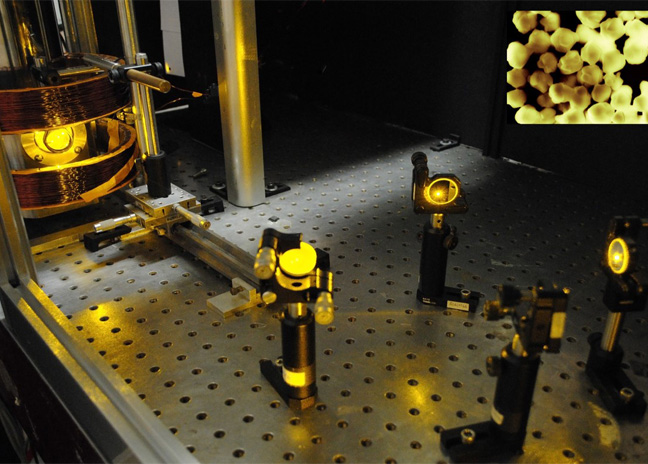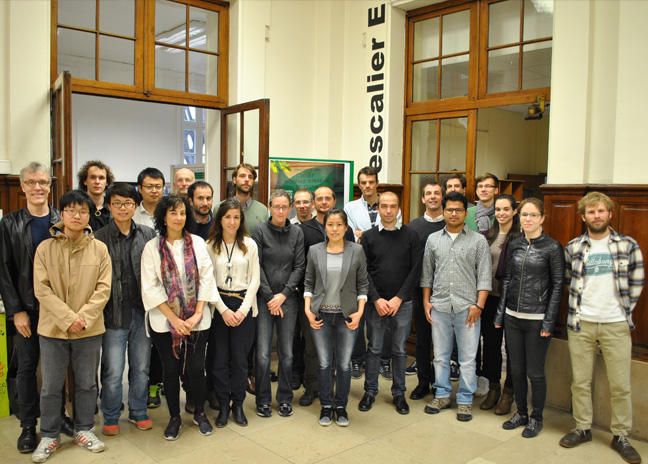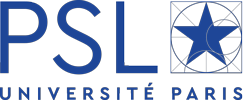Research project in quantum technologies NanOQTech win the Stars of Europe Trophy
The NanOQTech (Nanoscale Systems for Optical Quantum Technologies) project, run by Philippe Goldner, won the Stars of Europe Trophy, held for the 8th year, along with 11 other projects.
We take this opportunity to publish again the interview with Philippe Goldner et Diana Serrano (Chimie Paris - PSL), which took place in July 2018.

|
Update On December 16, 2020, on the 8th celebration of the Stars of Europe, twelve French scientific projets were rewarded; all of them are included in the Horizon 2020 program. PSL is proud that, among the winners, is the NanOQTech (Nanoscale Systems for Optical Quantum Technologies) project, run by Philippe Goldner, CNRS researcher at Institut de Recherche de Chimie Paris (Chimie Paris - PSL). NanOQTech received support from PSL in 2015 to answer the FET OPEN call for proposals. |
- Philippe Goldner eis a researcher at the Chimie Paris research institute, head of the Crystals and Dynamics of Quantum States group. He is also coordinator of the NanOQTech European project.
- Diana Serrano is a researcher at the Chimie Paris research institute within the Crystals and Dynamics of Quantum States group. She is also manager of the NanOQTech European project.
PSL: Can you tell us more about the NanOQTech project (Nanoscale Systems for Optical Quantum Technologies)?
Philippe Goldner: NanOQTech is a project funded by the FET Open, a highly competitive sub-program of Horizon 2020. It selects research projects that are forward-thinking, interdisciplinary, combining science and engineering to transform Europe’s scientific excellence into a competitive advantage. The project involves eight laboratories, including our colleagues at the Observatoire de Paris-PSL SYRTE as well as researchers from Institut Néel in Grenoble, Lund University, Aarhus University, the Karlsruher Institut für Technologie, the Institute of Photonic Sciences in Barcelona and one industrial partner: Keysight Technologies. I am the coordinator, and Diana is manager. The overall aim of the project is to demonstrate the usefulness of doping nanometric materials with rare-earth elements for quantum technologies, particularly those that use light.
Diana Serrano: You have to keep in mind that future (and current) improvements to our computers and means of communication rely on quantum technologies. While it has been proven that nanometric systems controlled by light bring key functionalities to quantum technologies for communication, computing, and detection, our primary challenge is now to extend as far as possible the life span of the quantum states at this scale for as long as possible. We believe that rare-earth elements inserted into nanoparticles offer intriguing properties to this end.
PSL: NanOQTech is a 3-year project. Now, at the halfway point, you have just published an article in Nature Communications presenting your latest results. What is their significance for your research work and for the second half of the project?
We are partners of two new projects (SQUARE and ASTERIQS) selected as part of the European Flagship on Quantum Technologies project, with a budget of €1 billion.
DS: To be completely accurate, the publication in Nature Communications builds upon the work we published last year in Nano Letters. Still, it is an important advance both in the field and toward our initial objectives, which we are especially proud of since we strive to set ambitious objectives for this type of project.
As Philippe said, our initial hypothesis was that rare earth spins in nanoparticles had useful properties, but we were not entirely sure how to measure them. In the end, we were able to develop a novel measurement technique which demonstrated that the quantum properties of millimeter-scale crystals can essentially be applied to nanoparticles. The ability the use these materials on a smaller scale will allow for their inclusion in micro- and nanophotonic devices, and the results are extremely promising to that end. They enabled us to submit, as partners, two new projects under the European Flagship on Quantum Technologies, with a budget of one billion euros. These projects, SQUARE and ASTERIQS, have just been selected.
PSL: This is very upstream research, but you are already envisioning its primary applications. What would they be?
Winning a FET Open doesn’t happen every day; when we submitted our application, 11 projects were selected out of 800, which is a success rate below 2%. A very tight consortium that know each other well is a big advantage toward being selected.
PG: First of all, there’s the use of nanoparticles doped with rare-earth elements as components of future quantum computers. Our research would also support the development of simulation and computation tools that are beyond the reach of current computers. We are also envisioning applications in the field of quantum communications and, more specifically, secure data transmission. Optical fiber, for example, which is commonly used to transmit large quantities of information, could be paired with nanoparticles doped with rare-earth elements to serve as memory for the quantum information. Secure flows of quantum communication over large distances could then be established. This is a very active field: a Chinese satellite has been launched, for example, to establish quantum communications. The field of research is developing quickly.
DS: With the NanOQTech project, we are also exploring the use of nanostructures doped with rare-earth elements for new force sensors and single-photon sources. And we’re working on couplings between rare earth elements and graphene, which would offer new applications in optoelectronics.
PSL:The FET Open program is extremely selective. How did you prepare your application package, and could you give a word of advice to other scientists hoping to submit their projects?
European projects are a wonderful opportunity to increase the visibility of the discipline, form scientific networks, and advance careers. Talking with the EU Affairs department at our institutions is an excellent way to save time and maximize your chances of success.
PG: You’ll need plenty of patience--in fact, we submitted this project twice. Rather than being discouraging, it’s actually a very good thing, because each project receives a detailed report from the evaluators. Their feedback is useful and helpful in enriching and clarifying the project. We also received assistance from PSL and from an expert in putting together European projects. If I had one piece of advice, it would be to contact the EU Affairs managers at your institutions! European projects are a wonderful opportunity to increase the visibility of the discipline, form scientific networks, and advance careers, but they must be written using very specific, sometimes slightly obscure language. Talking with experts, such as EU Affairs at our institutions, is an effective way to save time and maximize your chances of success.
Participating in projects as a partner before coordinating one is also a very useful experience. I drew heavily on my previous projects in writing up and now coordinating NanOQTech. These experiences have helped me anticipate each step and, most importantly, develop a strong network of collaborators. Coordination is no simple task, and working with partners you know well makes it much easier. Winning a FET Open doesn’t happen every day; when we submitted our application, 11 projects were selected out of 800, which is a success rate below 2%! The project budget is €3.4 M, of which approximately €700k is given to our team. A very tight consortium that know each other well is a big advantage toward being selected.

